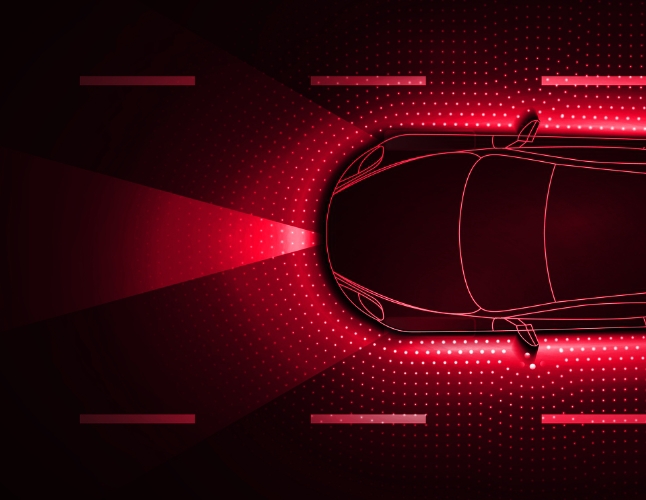From the pages of science fiction books to our roads, autonomous vehicles are becoming a reality. Most modern self-driving cars are currently capable of certain automated driving tasks, such as lane keeping and adaptive cruise control, and technology is progressing rapidly toward full automation.
While it can seem magical to those less technologically minded, the mystery of automation is a result of advanced sensors that provide real-time data about the environment to the vehicle’s onboard computer, which processes the data and makes decisions about how to control the vehicle.
Sensors are critical components of any advanced driver-assistance system (ADAS). They determine the quality of data put into the system, and therefore the quality of autonomous decision-making. There are a number of different types of sensors available, each of which uses a different technology to provide information about the vehicle environment.
Light Detection and Ranging (LIDAR), Radio Detection and Ranging (RADAR), and cameras are the most common sensors used in ADAS and in this article we will be taking a look at each of these.
Let There be Light: The Use of LIDAR in Autonomous Vehicles
LIDAR uses laser light to detect and measure distances between objects. There are different types of LIDAR technologies available, but in general, each of them emits laser pulses that bounce off objects in the environment and return to the sensor, allowing the system to create a 3D map of the environment.
The most common types of LIDAR used in the autonomous vehicle industry include:
- Time of Flight (ToF) LIDAR uses a laser pulse.
- Frequency-Modulated Continuous Wave (FMCW) LIDAR uses a continuous laser beam.
- Scanning LIDAR uses a rotating laser beam.
- Flash LIDAR uses a single laser pulse.
Each has its own advantages and disadvantages, and the choice of LIDAR sensor depends on the specific requirements of the autonomous vehicle application. Manufacturers may also use a combination of different LIDAR sensors to achieve the desired level of performance and reliability.
In general, LIDAR sensors are highly accurate, making them ideal for self-driving vehicles. They are also effective in low-light conditions and can accurately detect objects in rain, fog, and snow. However, LIDAR sensors are relatively expensive, and they can be affected by some environmental factors, such as dust and smoke.
Riding Those Radio Waves: The Case for RADAR Sensors in Autonomous Technology
LIDAR and RADAR operate off similar principles but RADAR technology uses radio waves to detect the presence and location of objects rather than light. The RADAR sensor emits a radio signal that bounces off objects in its path, and the sensor then receives the reflected signal. By analyzing this signal, the RADAR can determine the location, speed, and direction of detected objects and this information can in turn be used to predict their future movement and trajectory.
RADAR can transmit and receive signals over longer distances than LIDAR, making it useful for detecting objects at greater ranges.
There are several other advantages to using RADAR in autonomous vehicles. RADAR can operate in a wider range of weather conditions compared to LIDAR and cameras – an important feature given that vehicles have to operate in all types of unpredictable weather conditions. RADAR is also less expensive than LIDAR, making it a cost-effective option for many applications.
On the downside, RADAR sensors have lower resolution capabilities than LIDAR or cameras which can make it more difficult to identify small objects or distinguish between similar objects. Another limitation is that RADAR can be affected by interference from other RADAR systems, which can reduce its accuracy.
And Action! The Role of Cameras in Driverless Technology
Cameras are the most familiar type of sensor to most people. They capture images or video of the environment which can be used to detect and identify objects, such as pedestrians, other vehicles, traffic lights, and road signs.
Regular single-lens or monoscopic cameras capture a 2D image which does not provide depth information about the objects in the scene – a distinct disadvantage for automated vehicle applications.
In order to overcome this limitation while still retaining all the other benefits of camera sensors, stereoscopic cameras have become a popular solution. These sensors make use of two lenses placed a fixed distance apart to capture two slightly different images of the same scene. These two images are then combined to create a 3D representation of the scene, providing more accurate depth information about the objects in the environment.
Overall, cameras are a critical component of autonomous and ADAS systems.
They are relatively inexpensive and have high-resolution capabilities, making them a popular choice for self-driving cars. However, cameras have limitations, particularly in low-light conditions, and they can struggle to accurately identify objects at long distances.
What's Going to Work? Teamwork! Combining Sensors for Maximum Performance
Cameras, LIDAR, and RADAR each have their own strengths and weaknesses, and it is clear that no single sensor can be sufficient to provide all necessary data to an autonomous vehicle. Rather, by combining data from multiple sensors, the vehicle can build a comprehensive picture of its surroundings and navigate safely and efficiently.
Foresight offers cost-efficient and scalable ways of integrating stereoscopic technology into existing ADAS systems and makes use of a number of advanced software solutions to achieve unprecedented obstacle detection. Visit our website or contact us for more information.



